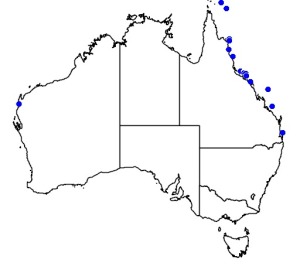
©Anne Hoggett: Two Crown-of-thorns Starfish (COTS) feeding on a large table coral (Acropora, more than 3 metres in diameter). White patches on the coral are dead skeleton, left after the COTS have eaten the living tissue.

©Anne Hoggett: Four Crown-of-thorns Starfish under a table coral. Three are feeding on the underside of the coral.
Colours
Distinguishing features
Size
- Up to 62 cm (diameter of largest specimen recorded at Lizard Island (Pratchett, 2005))
Depth range
- Depth range data is not yet available.
Synonyms
Similar taxa
-
Animalia:
species: Acanthaster planci
was considered to be a single, widely-distributed species until Vogler et al (2008) discovered that there are at least four species in the Indo-Pacific. The name proposed for the species present on the Great Barrier Reef (Haszprunar et al, 2017) is Acanthaster solaris but additional taxonomic work is needed before that name can be applied unequivocally. In the meantime, it is referred to as Acanthaster solaris cf.
Distribution
Behaviour
Spawning observations at Lizard Island:
6 Dec 2013: Lyle Vail and Anne Hoggett killed 37 COTS in 40 minutes on snorkel at the northern end of Big Vicki's Reef between 1800 and 1840. This was just before low tide (0.86 m at 1847), three days after the new moon. One male was spawning profusely from on top of a coral head. Water was very cloudy at start of snorkel indicating others had spawned recently. Normal distribution of individuals, no sign of aggregation, no photos.
18 Dec 2009: At least 12 COTS observed spawning by Anne Hoggett and Lyle Vail on reef crest and slope between South and Palfrey Islands between 4.30 and 5 pm. This was at low tide (1.0 m at 1648) two days after the new moon. All were males, extreme quantities of white sperm distinctly reduced visibility not just in immediate area but generally. Individuals were well spaced from each other, from about 3 to tens of metres from the nearest. Most were exposed on top of coral heads but some were within branching Acropora. Almost all COTS observed were spawning, have photos. When/where do the females do it?
Danielle Dixson observed a COTS on display in the LIRS aquarium spawn the following day (19 Dec 2009) at about 4.30 pm. It appeared to be a female.
Lyle and Anne went back to South/Palfrey for two dives on 19 Dec 2009. No spawning observed on either dive. Killed about 12 COTS on morning dive (about 1045 to 1200, South Island end) and another 12 in the late afternoon (about 1645 to 1745, more towards Palfrey).
1983: Bill Gladstone saw 20 to 30 COTS - all male - spawning on a summer morning. They climbed to the tops of coral heads as the tide was falling and exuded clouds of sperm for 20 to 30 minutes. Bill noted that the animals were well spaced, 3 to 4 metres apart. (Gladstone, 1988).
Web resources
References
References that assist with identification
- Haszprunar, G., C. Vogler and G. Wörheide (2017). Persistent gaps of knowledge for naming and distinguishing multiple species of Crown-of-Thorns-Seastar in the Acanthaster planci species complex, Diversity, 9: 22. LIRS catalog number 90243.
- Marsh, L.M. and J. Fromont (2020). Field Guide to shallow water seastars of Australia. Western Australian Museum, Perth.
- Vogler, C., J. Benzie, H. Lessios, P. Barber and G. Wörheide (2008). A threat to coral reefs multiplied? Four species of crown-of-thorns starfish. Biology Letters, 4: 696-699. LIRS catalog number 90271.
- View all references









